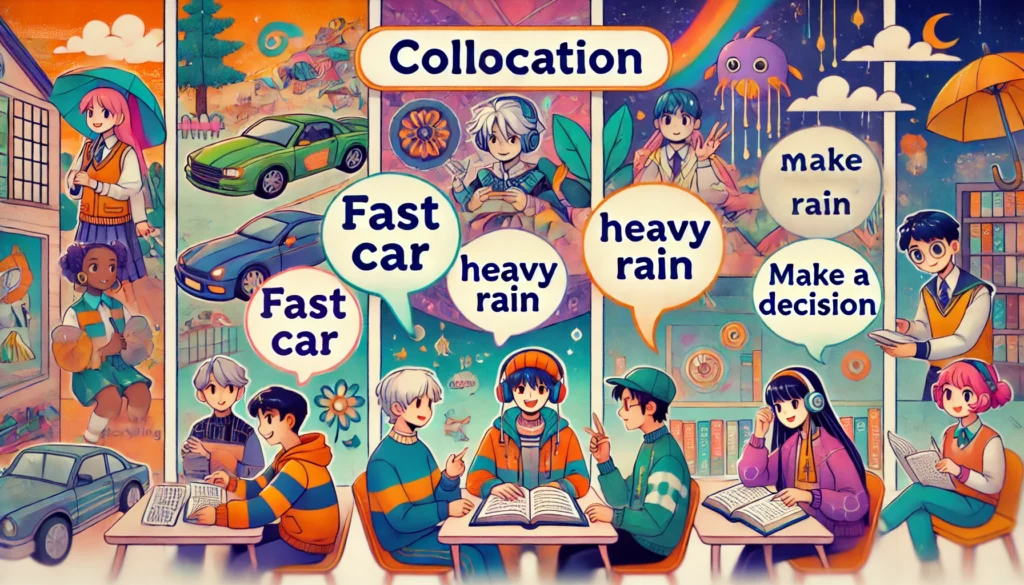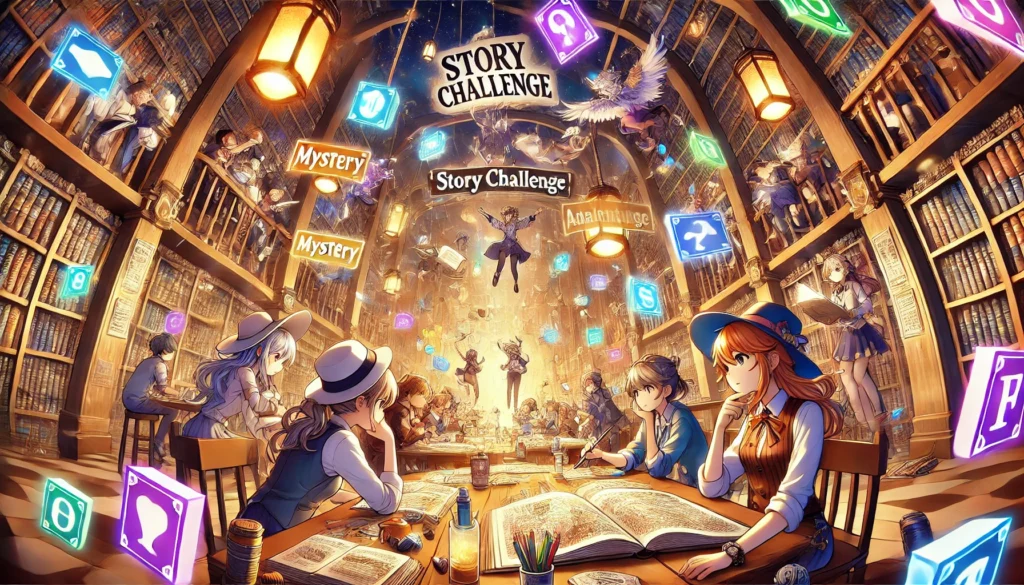COLLOCATIONS

Learning Goals
- Understand what collocations are and why they are important in both spoken and written communication.
- Identify and use common collocations in context.
- Apply collocations to enhance your fluency and naturalness in communication.
What Are Collocations?
Collocations are combinations of words that go together naturally in English. They help make your speech and writing sound more fluent and natural. But here’s the fun part: not all words can go together! Some words fit perfectly, while others don’t.
Examples of Collocations:
- Make an effort (not “do an effort”)
- Take a shower (not “do a shower”)
- Heavy rain (not “strong rain”)
- Pay attention (not “give attention”)
- A quick decision (not “a fast decision”)
Why Are Collocations Important?
- Fluency: Using collocations makes you sound like a native speaker.
- Clarity: The right combination of words makes your meaning clearer.
- Naturalness: You sound more natural and confident in English.
Contextual Understanding of Collocations
Context means the situation or environment where you are using language. It helps you choose the right collocation. For example, collocations that work in a formal setting might not sound right in a casual conversation.
Let’s break it down:
1. Casual Conversation (Informal)
In casual conversation, you’ll use more relaxed and simple collocations. These are used when talking to friends, family, or people you’re comfortable with.
Example Collocations:
- Grab a bite – (informal way of saying “eat”)
- “Let’s grab a bite after the movie.”
- Hang out – (spend time with someone)
- “We should hang out this weekend!”
- Chill out – (relax or calm down)
- “Just chill out, everything’s going to be fine!”
2. Formal Communication
When you are in a more formal situation, like writing an essay, giving a speech, or talking in a meeting, you need more formal collocations.
Example Collocations:
- Make a decision – (to decide something)
- “The board needs to make a decision by the end of the week.”
- Conduct research – (to do research)
- “The scientist will conduct research on climate change.”
- Give a presentation – (to present information to others)
- “I’m preparing to give a presentation at the conference.”
Fun Examples of Collocations in Context
- Making Decisions
- Collocation: “Make up your mind”
- Example: “I can’t decide whether to go to the beach or stay at home. I need to make up my mind.”
- Context: This collocation is used when someone is struggling to decide or come to a conclusion.
- Everyday Activities
- Collocation: “Do the dishes”
- Example: “Hey, can you help me? I need to do the dishes after dinner.”
- Context: This is a common expression used for household chores. It’s not “make the dishes” or “clean the dishes”—it’s specifically do.
- Talking About Time
- Collocation: “Spend time”
- Example: “I love to spend time with my family on the weekends.”
- Context: We use this collocation when we’re talking about how we use or dedicate our time.
- Feelings or Emotions
- Collocation: “Feel excited”
- Example: “I’m so excited to see the new movie this weekend!”
- Context: When talking about emotions, collocations like feel excited or feel sad are commonly used.
- Making Plans
- Collocation: “Make plans”
- Example: “Let’s make plans to hang out this Saturday!”
- Context: This is a common collocation when talking about arranging something with someone.
- Physical Actions
- Collocation: “Take a deep breath”
- Example: “When you’re nervous, just take a deep breath and relax.”
- Context: This collocation is used when talking about calming down or managing stress.
- Workplace and Professional
- Collocation: “Meet a deadline”
- Example: “I’ve been working all week to meet the deadline for this project.”
- Context: This is used in work or school settings to describe finishing something on time.
- Social Situations
- Collocation: “Make a good impression”
- Example: “When you meet someone for the first time, you should always make a good impression.”
- Context: This collocation is used when discussing how someone is perceived or the effect they have on others.
- Health
- Collocation: “Get in shape”
- Example: “I’m going to the gym to get in shape for the summer.”
- Context: This is used when talking about improving physical fitness.
- Food and Eating
- Collocation: “Grab a bite”
- Example: “Let’s grab a bite to eat before the movie.”
- Context: A casual, fun way of saying “let’s go eat.”
Collocations in Spoken and Written Communication
1. Spoken Communication Collocations
Spoken communication refers to any conversation or dialogue where you speak to someone, whether casually or in a formal setting. In spoken language, we often use more informal and conversational collocations.
A. “Take a break”
- Example: “Let’s take a break from studying.”
- Explanation: This is a common collocation used when you stop doing something for a short time to rest. It’s used in both casual and professional settings.
B. “Catch up”
- Example: “I need to catch up on homework this weekend.”
- Explanation: This means to do something that you have missed or been behind on. For example, if you haven’t been able to finish your tasks or meet someone for a while, you would use catch-up.
C. “Make a decision”
- Example: “I can’t decide whether to go to the movies or stay home. I need to make a decision.”
- Explanation: This collocation is used when you are thinking carefully about choosing between two or more options.
D. “Get along with”
- Example: “I really get along with my classmates.”
- Explanation: To get along with someone means to have a good relationship or to be friendly with them. It’s common to use when talking about friends or classmates.
E. “Give advice”
- Example: “She always gives good advice about school projects.”
- Explanation: This means offering suggestions or guidance to someone. You give advice when you tell someone what you think is the best thing to do.
2. Written Communication Collocations
Written communication includes all forms of communication where you use writing, such as emails, essays, reports, or formal letters. In writing, we often use more formal collocations.
A. “Conduct research”
- Example: “The team will conduct research to find the best solution.”
- Explanation: Conduct research is a formal collocation used when referring to gathering information in a structured way, especially in academic, scientific, or business contexts.
B. “Make progress”
- Example: “She’s been working hard and has really made progress in her English skills.”
- Explanation: Making progress means to improve or advance in something. You can use this to talk about personal growth, learning, or work projects.
C. “Write an essay”
- Example: “You need to write an essay about your favorite book.”
- Explanation: Writing an essay is used when referring to writing a formal piece of writing on a topic, usually in school.
D. “Send an email”
- Example: “I’ll send an email to the teacher about the homework.”
- Explanation: This is a very common collocation used when you need to email someone, especially in professional or academic contexts.
E. “Make an announcement”
- Example: “The principal will make an announcement about the school trip tomorrow.”
- Explanation: Making an announcement is used when you are telling a group of people important information. It’s often used in formal or public settings.
Additional Resources
Here are two videos explaining the importance of collocations in English and how they help with fluency.
Learning Activities
General
Activity 1: Matching Collocations to Contexts
Context 1: You’re at a family dinner, talking to your cousin about school.
- Possible Collocations:
- Take a break
- Give advice
- Make progress
Which one would you use here?
- Answer: You would say, “I need to take a break from studying” or “I give advice to my classmates about time management”.
Context 2: You’re at work, discussing a project with your boss.
- Possible Collocations:
- Meet a deadline
- Get along with
- Catch up on work
Which one works best here?
- Answer: “We need to meet the deadline for the project.” or “I need to catch up on work after being away last week.”
Activity 2: Collocation Charades Game
Objective: Use body language and gestures to help your classmates guess the collocation.
- Write a list of collocations (both formal and informal) on slips of paper (e.g., take notes, make a decision, grab a coffee).
- In pairs, one student will act out the collocation without speaking, and the other student must guess the correct collocation.
- Afterward, the group will discuss when that collocation might be used (formal vs. informal context).
Activity 3: Collocation Sentence Challenge
Now, you’ll get a list of collocation halves and need to match them to complete the sentence correctly.
- Make
- Take
- Give
- Get
- Have
- A: a good impression
- B: responsibility
- C: an effort
- D: it’s easy
- E: a shower
Challenge: Can you match them to make correct sentences?
EGB
Collocation Sorting Game
Objective: Categorize common collocations correctly.
Instructions:
- Write down several words on slips of paper (e.g., pay, take, strong, fast, make, heavy).
- On separate pieces of paper, write potential collocation pairs (e.g., pay attention, make an effort, take a break, strong coffee).
- In groups, students will sort the slips into the correct collocation pairs.
- After sorting, each group will share their results and explain why those combinations make sense.
Variation: Make the game more challenging by adding some “false” collocations and having students identify which ones are incorrect.

Collocation Storytelling
Objective: Practice using collocations in a creative context.
Instructions:
- In pairs, choose 5-7 collocations from a provided list (e.g., take a deep breath, make a promise, have a good time).
- Write a short story (3-4 sentences) using all of these collocations naturally.
- Once finished, you’ll read your story to another pair and check if they can identify all the collocations used.
Variation: For a more challenging version, try to create a story using only one word from the collocation list (e.g., only use “make” with different combinations: make a plan, make friends, make an effort).

BGU
Collocation Story Challenge
Objective: Create and present a story using advanced collocations.
Instructions:
- Write a short story (200-300 words) incorporating at least 10 advanced collocations.
- Use a variety of contexts in your story (e.g., work, school, hobbies, emotions) and make sure the collocations fit naturally in the sentences.
- After writing, you will present your story to the class and highlight the collocations you used.
Variation: As a challenge, present your story as a dialogue between two or more characters, making the conversation more dynamic.

Collocation Pictionary
Objective: Illustrate and guess collocations based on their meaning.
Instructions:
- Write down different collocations (e.g., catch a cold, make progress, have a conversation) on slips of paper.
- In groups, one person will draw the meaning of a collocation on a whiteboard or paper, and their team must guess the correct collocation.
- Time limit: Each team has 1 minute to guess the collocation based on the drawing.
Variation: Add a point for each team that uses the collocation correctly in a sentence after guessing it.

